Tsoulfanidis N. Measurement and detection of radiation
Подождите немного. Документ загружается.

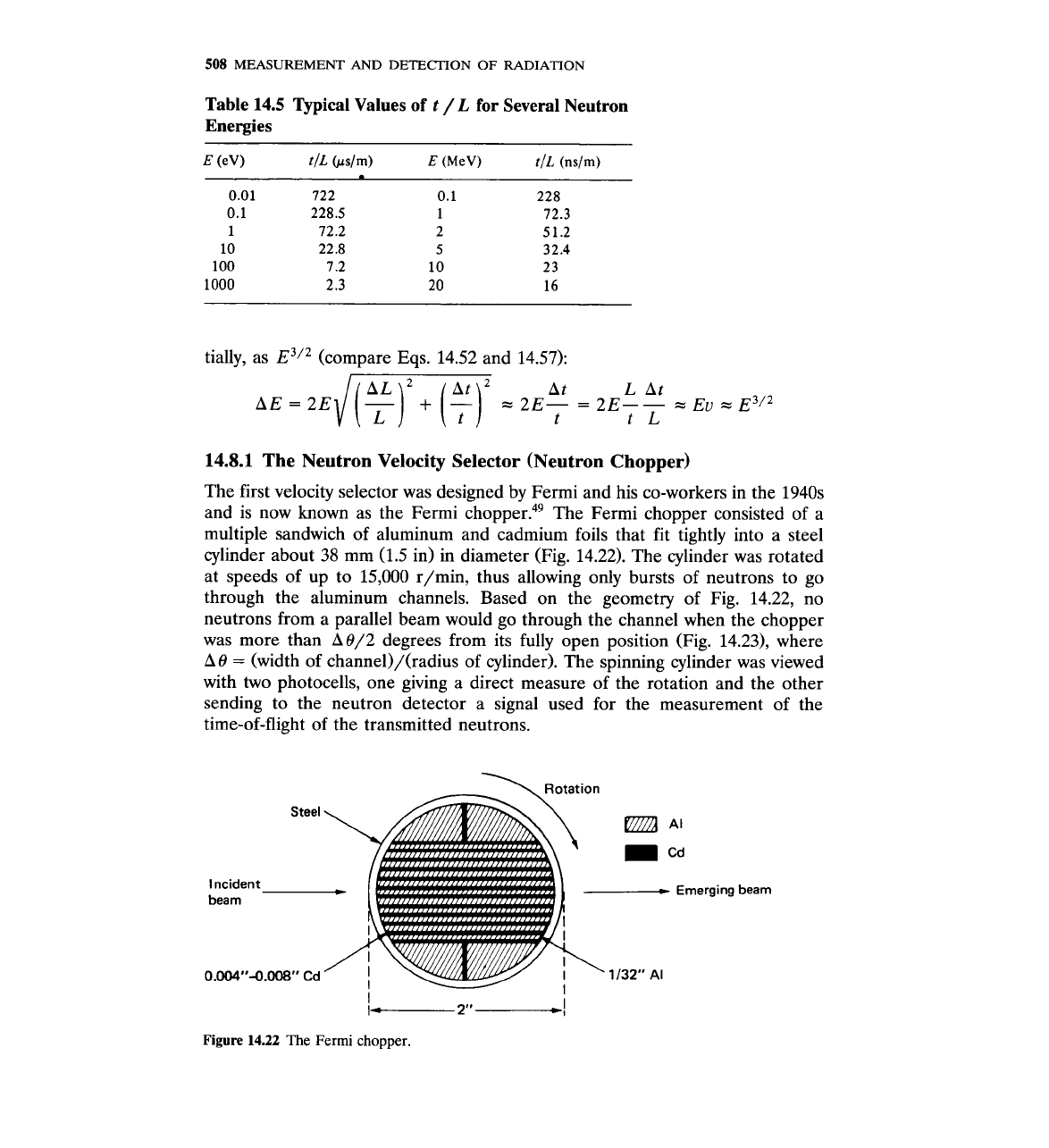
508
MEASUREMENT
AND
DETECTION
OF
RADIATION
Table
14.5
Typical Values of
t
/
L
for Several Neutron
Energies
--
E
(eV)
t/L
bslm)
E
(MeV)
1/15
(nslm)
0.01
722
0.1
228
0.1
228.5
1
72.3
1
72.2 2 51.2
10
22.8 5 32.4
100
7.2
10
23
1000 2.3 20 16
tially, as
E~/~
(compare Eqs. 14.52 and 14.57):
14.8.1
The Neutron Velocity Selector (Neutron Chopper)
The first velocity selector was designed by Fermi and his co-workers in the 1940s
and is now known as the Fermi chopper.49 The Fermi chopper consisted of a
multiple sandwich of aluminum and cadmium foils that fit tightly into a steel
cylinder about
38
mm (1.5 in) in diameter (Fig. 14.22). The cylinder was rotated
at speeds of up to 15,000 r/min, thus allowing only bursts of neutrons to go
through the aluminum channels. Based on the geometry of Fig. 14.22, no
neutrons from a parallel beam would go through the channel when the chopper
was more than A8/2 degrees from its fully open position (Fig. 14.23), where
A8
=
(width of channel)/(radius of cylinder). The spinning cylinder was viewed
with two photocells, one giving a direct measure of the rotation and the other
sending to the neutron detector a signal used for the measurement of the
time-of-flight of the transmitted neutrons.
Incident,
beam
Steel
ging beam
Figure
14.22
The
Fermi chopper.
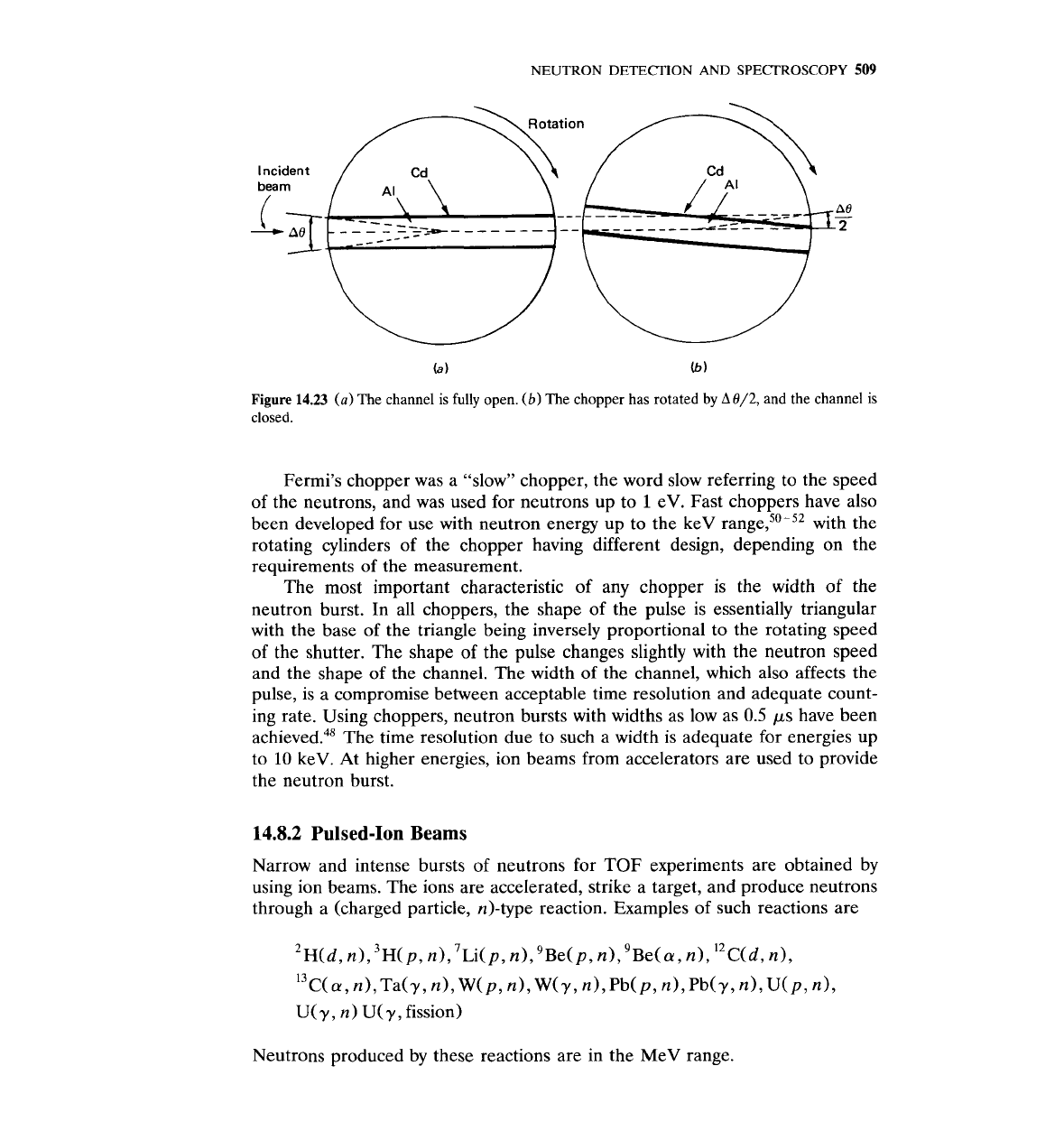
NEUTRON
DETECTlON
AND
SPECTROSCOPY
509
Incident
beam
Figure 14.23
(a)
The channel is fully open.
(b)
The chopper has rotated
by
AO/2,
and the channel is
closed.
Fermi's chopper was a "slow" chopper, the word slow referring to the speed
of the neutrons, and was used for neutrons up to
1
eV. Fast choppers have also
been developed for use with neutron energy up to the keV range,50-52 with the
rotating cylinders of the chopper having different design, depending on the
requirements of the measurement.
The most important characteristic of any chopper is the width of the
neutron burst. In all choppers, the shape of the pulse is essentially triangular
with the base of the triangle being inversely proportional to the rotating speed
of the shutter. The shape of the pulse changes slightly with the neutron speed
and the shape of the channel. The width of the channel, which also affects the
pulse, is a compromise between acceptable time resolution and adequate count-
ing rate. Using choppers, neutron bursts with widths as low as
0.5 ps have been
a~hieved.~' The time resolution due to such a width is adequate for energies up
to
10
keV. At higher energies, ion beams from accelerators are used to provide
the neutron burst.
14.8.2
Pulsed-Ion
Beams
Narrow and intense bursts of neutrons for TOF experiments are obtained by
using ion beams. The ions are accelerated, strike a target, and produce neutrons
through a (charged particle, n)-type reaction. Examples of such reactions are
Neutrons produced by these reactions are in the MeV range.
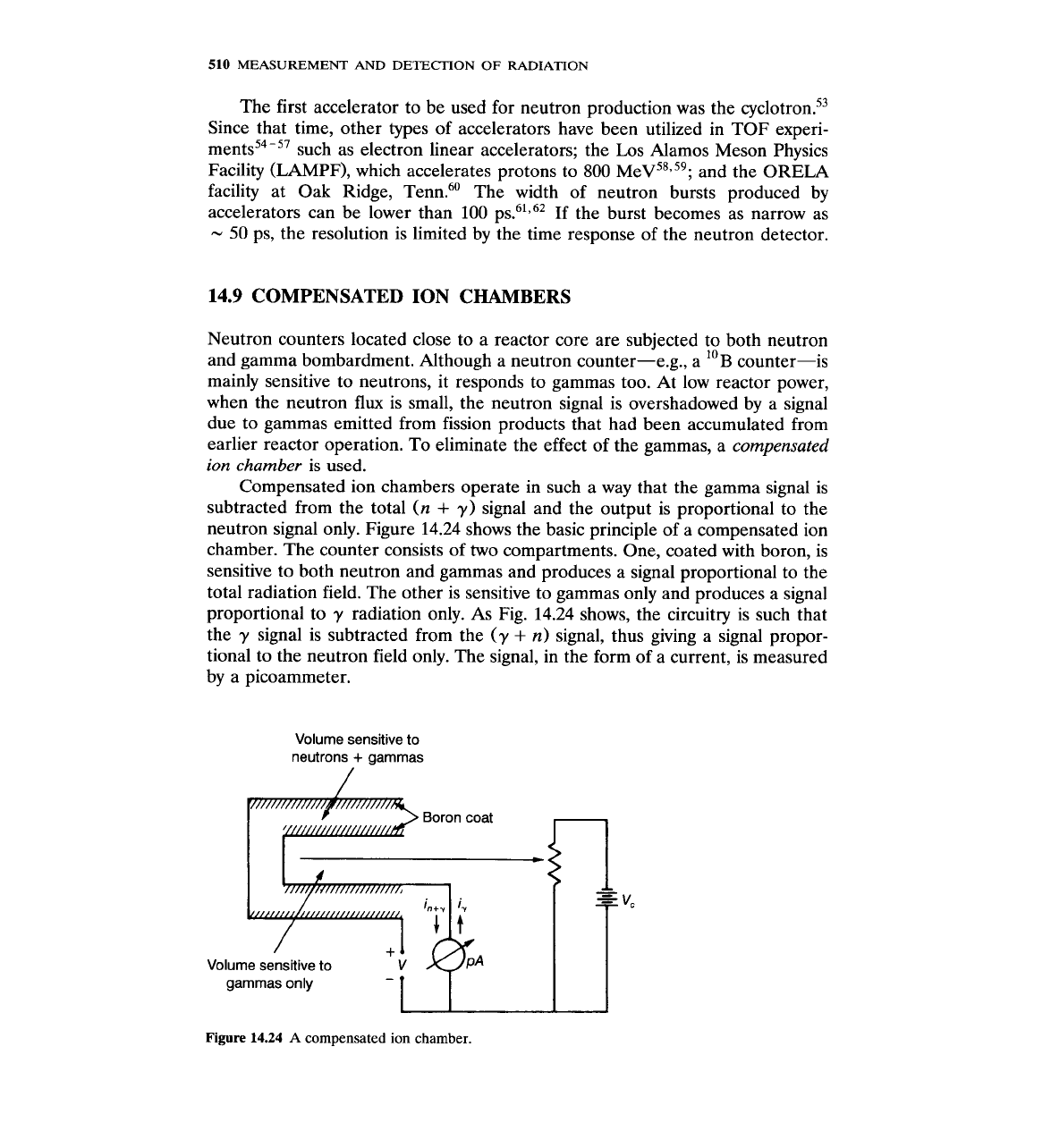
510
MEASUREMENT
AND
DETECTION
OF
RADIATION
The first accelerator to be used for neutron production was the cyclotron.53
Since that time, other types of accelerators have been utilized in TOF experi-
ment~~~-~~ such as electron linear accelerators; the Los Alamos Meson Physics
Facility (LAMPF), which accelerates protons to
800
M~v~~.~~; and the ORELA
facility at Oak Ridge, ~enn.~' The width of neutron bursts produced by
accelerators can be lower than
100
ps.61,62 If the burst becomes as narrow as
-
50
ps, the resolution is limited by the time response of the neutron detector.
14.9
COMPENSATED ION CHAMBERS
Neutron counters located close to a reactor core are subjected to both neutron
and gamma bombardment. Although a neutron counter-e.g., a
'OB
counter-is
mainly sensitive to neutrons, it responds to gammas too. At low reactor power,
when the neutron
flux
is small, the neutron signal is overshadowed by a signal
due to gammas emitted from fission products that had been accumulated from
earlier reactor operation. To eliminate the effect of the gammas, a compensated
ion
chamber
is used.
Compensated ion chambers operate in such a way that the gamma signal is
subtracted from the total
(n
+
y) signal and the output is proportional to the
neutron signal only. Figure 14.24 shows the basic principle of a compensated ion
chamber. The counter consists of two compartments. One, coated with boron, is
sensitive to both neutron and gammas and produces a signal proportional to the
total radiation field. The other is sensitive to gammas only and produces a signal
proportional to
y radiation only. As Fig. 14.24 shows, the circuitry is such that
the
y signal is subtracted from the (y
+
n) signal, thus giving a signal propor-
tional to the neutron field only. The signal, in the form of a current, is measured
by a picoammeter.
Volume sensitive to
neutrons
+
gammas
Boron coat
t
t
+
Volume sensitive to
V
-
gammas only
Figure
14.24
A
compensated ion chamber.
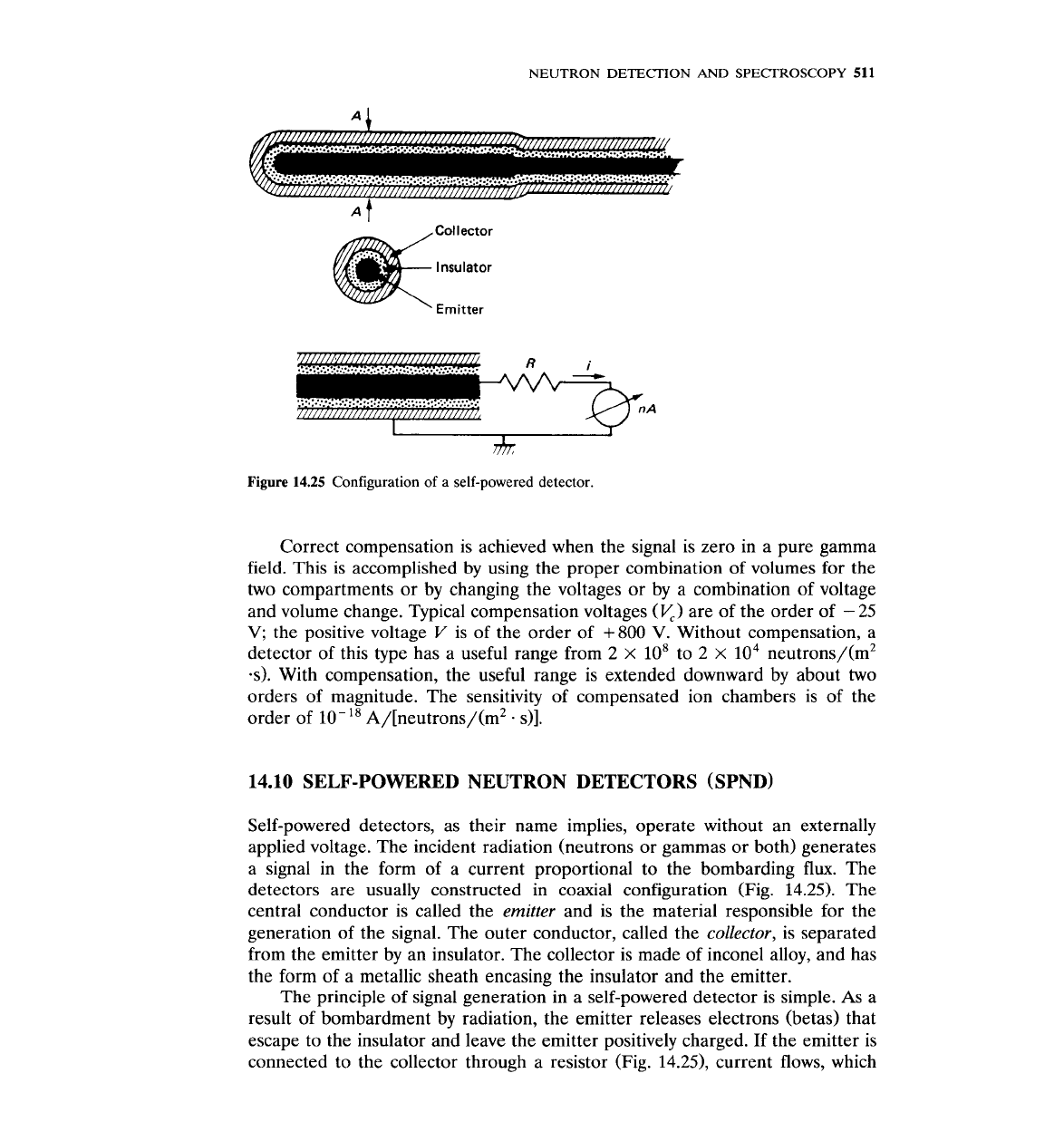
NEUTRON
DETECTION
AND
SPECTROSCOPY
511
Collector
l
nsulator
Emitter
Figure
14.25
Configuration of a self-powered detector.
Correct compensation is achieved when the signal is zero in a pure gamma
field. This is accomplished by using the proper combination of volumes for the
two compartments or by changing the voltages or by a combination of voltage
and volume change. Typical compensation voltages
(V,)
are of the order of
-
25
V;
the positive voltage V is of the order of
+800
V.
Without compensation, a
detector of this type has a useful range from 2
x
10' to 2
X
lo4
neutrons/(m2
d.
With compensation, the useful range is extended downward by about two
orders of magnitude. The sensitivity of compensated ion chambers is of the
order of 10-l8 ~/[neutrons/(m'
.
$1.
14.10
SELF-POWERED NEUTRON DETECTORS (SPND)
Self-powered detectors, as their name implies, operate without an externally
applied voltage. The incident radiation (neutrons or gammas or both) generates
a signal in the form of a current proportional to the bombarding
flux.
The
detectors are usually constructed in coaxial configuration (Fig. 14.25). The
central conductor is called the emitter and is the material responsible for the
generation of the signal. The outer conductor, called the collector, is separated
from the emitter by an insulator. The collector is made of inconel alloy, and has
the form of a metallic sheath encasing the insulator and the emitter.
The principle of signal generation in a self-powered detector is simple.
As
a
result of bombardment by radiation, the emitter releases electrons (betas) that
escape to the insulator and leave the emitter positively charged. If the emitter is
connected to the collector through a resistor (Fig. 14.251, current flows, which
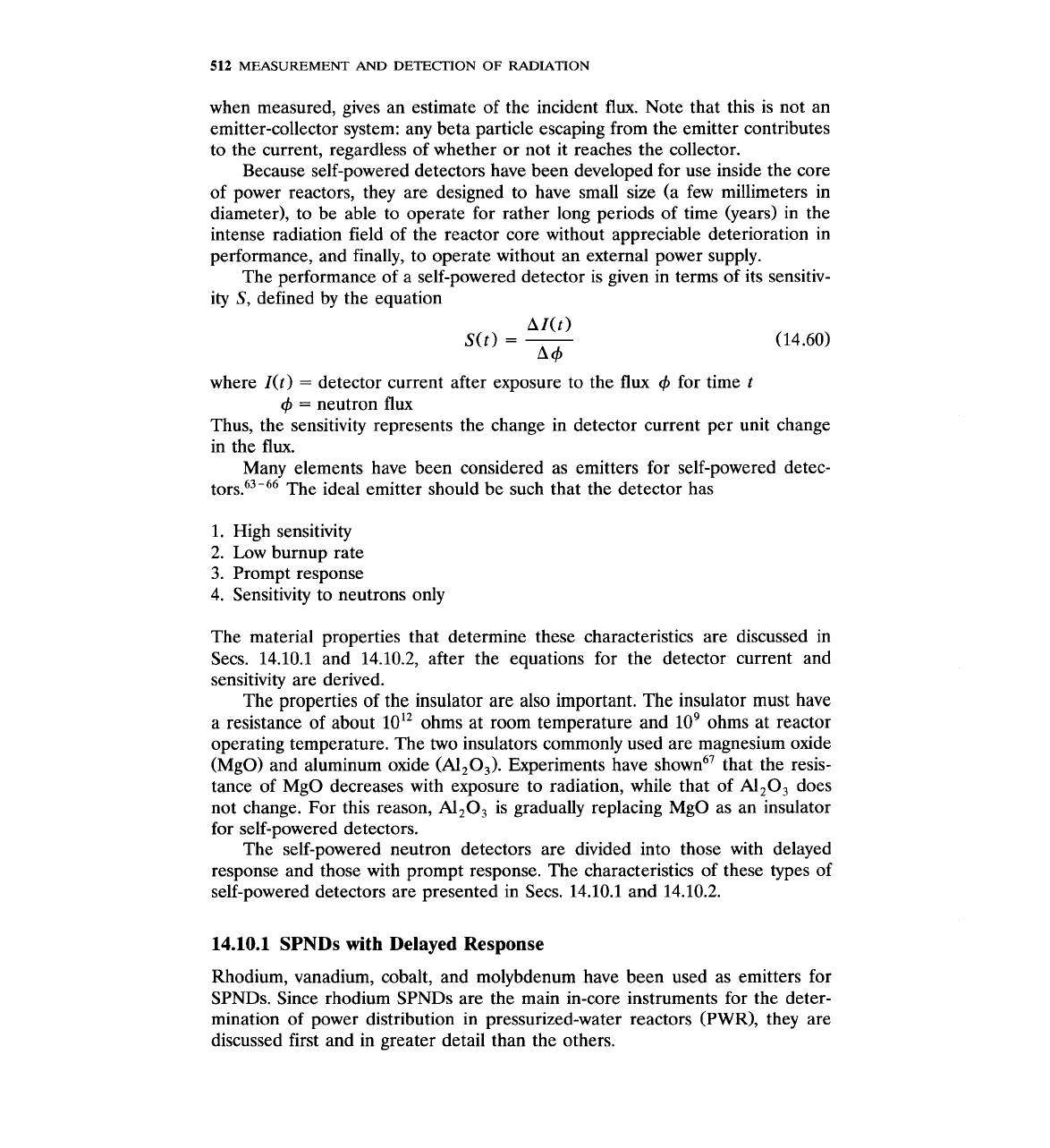
512
MEASUREMENT
AND
DETECTION
OF
RADIATION
when measured, gives an estimate of the incident
flux.
Note that this is not an
emitter-collector system: any beta particle escaping from the emitter contributes
to the current, regardless of whether or not it reaches the collector.
Because self-powered detectors have been developed for use inside the core
of power reactors, they are designed to have small size (a few millimeters in
diameter), to be able to operate for rather long periods of time (years) in the
intense radiation field of the reactor core without appreciable deterioration in
performance, and finally, to operate without an external power supply.
The performance of a self-powered detector is given in terms of its sensitiv-
ity
S,
defined by the equation
where I(t)
=
detector current after exposure to the
flux
4
for time t
C$
=
neutron
flux
Thus, the sensitivity represents the change in detector current per unit change
in the
flux.
Many elements have been considered as emitters for self-powered detec-
tor~.~~-~~ The ideal emitter should be such that the detector has
1.
High sensitivity
2. Low burnup rate
3.
Prompt response
4. Sensitivity to neutrons only
The material properties that determine these characteristics are discussed in
Secs. 14.10.1 and 14.10.2, after the equations for the detector current and
sensitivity are derived.
The properties of the insulator are also important. The insulator must have
a resistance of about
1012 ohms at room temperature and
lo9
ohms at reactor
operating temperature. The two insulators commonly used are magnesium oxide
(MgO) and aluminum oxide (Al,O,). Experiments have shown6" that the resis-
tance of MgO decreases with exposure to radiation, while that of A1203 does
not change. For this reason,
A1203 is gradually replacing MgO as an insulator
for self-powered detectors.
The self-powered neutron detectors are divided into those with delayed
response and those with prompt response. The characteristics of these types of
self-powered detectors are presented in Secs. 14.10.1 and 14.10.2.
14.10.1
SPNDs
with
Delayed Response
Rhodium, vanadium, cobalt, and molybdenum have been used as emitters for
SPNDs. Since rhodium SPNDs are the main in-core instruments for the deter-
mination of power distribution in pressurized-water reactors (PWR), they are
discussed first and in greater detail than the others.
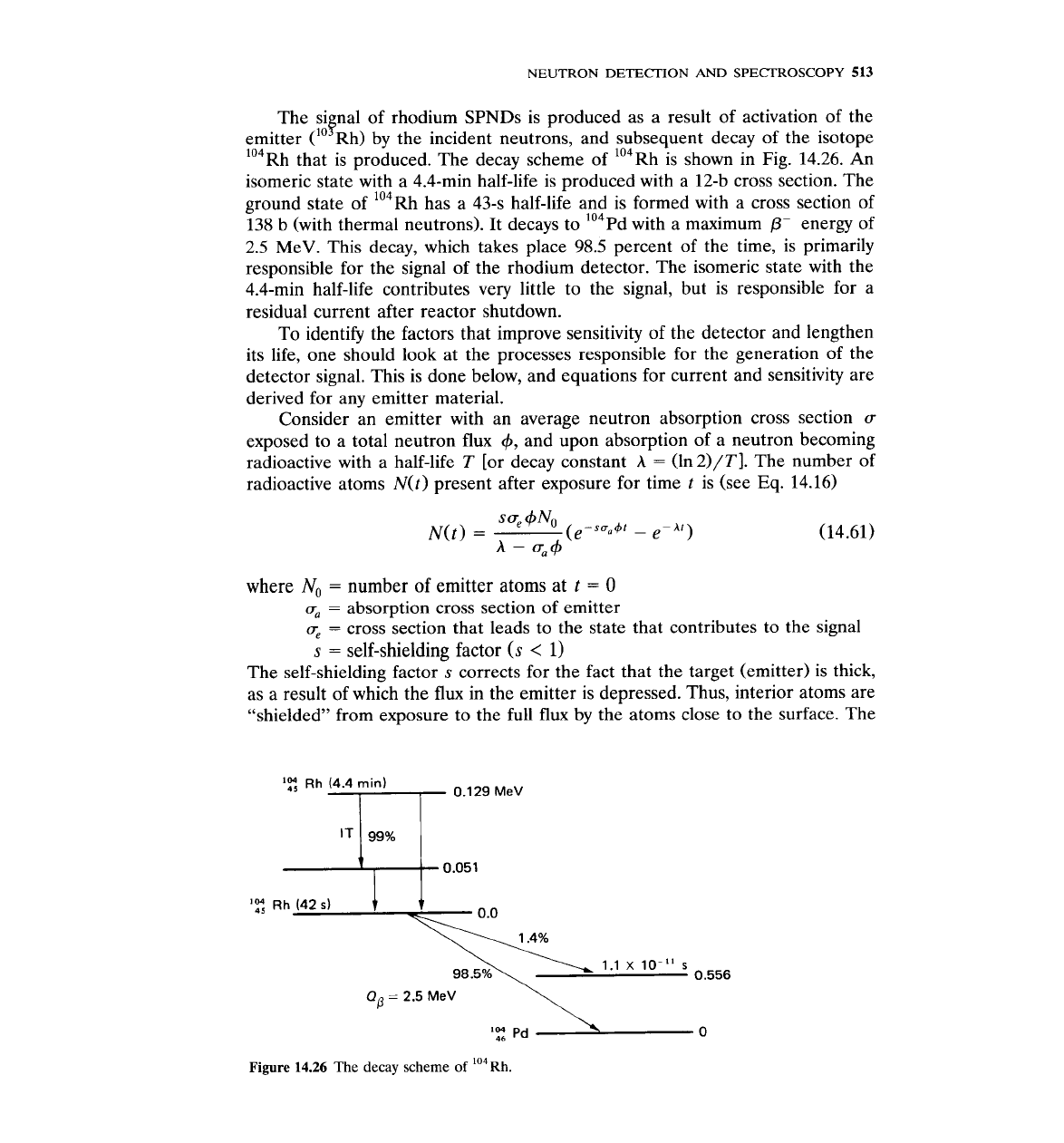
NEUTRON
DETECTION
AND
SPEmROSCOPY
513
The si nal of rhodium SPNDs is produced as a result of activation of the
mk
emitter
(
Rh) by the incident neutrons, and subsequent decay of the isotope
104
Rh that is produced. The decay scheme of lo4~h is shown in Fig. 14.26.
An
isomeric state with a 4.4-min half-life is produced with a 12-b cross section. The
ground state of lo4~h has a 43-s half-life and is formed with a cross section of
138
b (with thermal neutrons). It decays to '04pd with a maximum
P-
energy of
2.5 MeV. This decay, which takes place 98.5 percent of the time, is primarily
responsible for the signal of the rhodium detector. The isomeric state with the
4.4-min half-life contributes very little to the signal, but is responsible for a
residual current after reactor shutdown.
To identify the factors that improve sensitivity of the detector and lengthen
its life, one should look at the processes responsible for the generation of the
detector signal. This is done below, and equations for current and sensitivity are
derived for any emitter material.
Consider an emitter with an average neutron absorption cross section
a
exposed to a total neutron flux 4, and upon absorption of a neutron becoming
radioactive with a half-life T [or decay constant
h
=
(ln2)/T]. The number of
radioactive atoms N(t) present after exposure for time t is (see Eq. 14.16)
where
No
=
ua
=
ue
=
S
=
number of emitter atoms at
t
=
0
absorption cross section of emitter
cross section that leads to the state that contributes to the signal
self-shielding factor
(s
<
1)
The self-shielding factors corrects for the fact that the target (emitter) is thick,
as a result of which the
flux
in the emitter is depressed. Thus, interior atoms are
"shielded" from exposure to the full
flux
by the atoms close to the surface. The
Qp
=
2.5
MeV
\
Figure
14.26
The
decay
scheme
of
lo4~h.
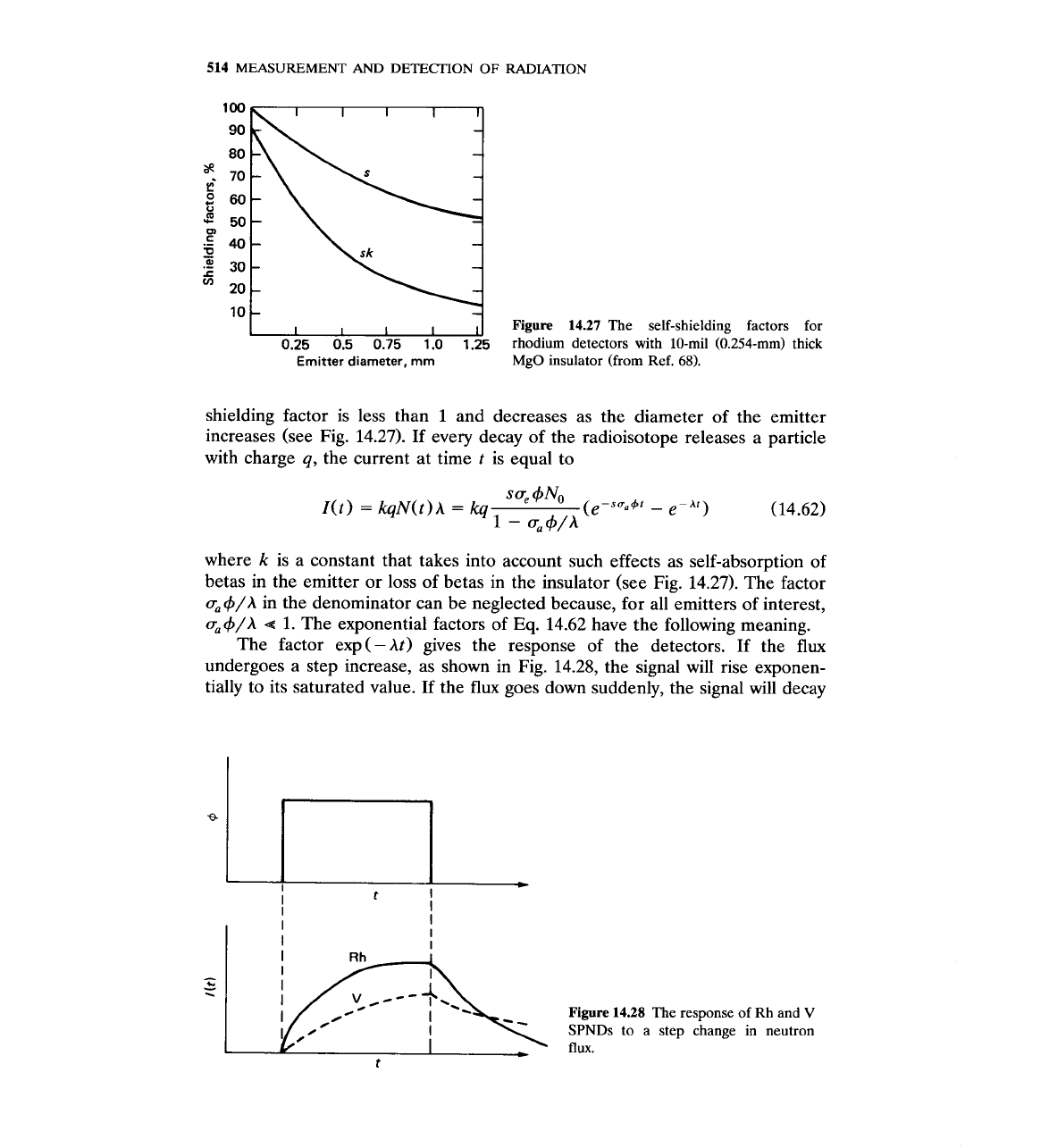
514
MEASUREMENT
AND
DETECTION
OF
RADIATION
0.25 0.5 0.75 1.0 1.25
Emitter diameter, mm
Figure
14.27
The
self-shielding factors for
rhodium detectors with 10-mil (0.254-mm) thick
MgO insulator (from Ref.
68).
shielding factor is less than
1
and decreases as the diameter of the emitter
increases (see Fig.
14.27).
If every decay of the radioisotope releases a particle
with charge
q,
the current at time
t
is equal to
where
k
is a constant that takes into account such effects as self-absorption of
betas in the emitter or loss of betas in the insulator (see Fig.
14.27).
The factor
ua4/A
in the denominator can be neglected because, for all emitters of interest,
aac$/A
e
1.
The exponential factors of
Eq.
14.62
have the following meaning.
The factor exp(-
At)
gives the response of the detectors. If the
flux
undergoes a step increase, as shown in Fig.
14.28,
the signal will rise exponen-
tially to its saturated value. If the
flux
goes down suddenly, the signal will decay
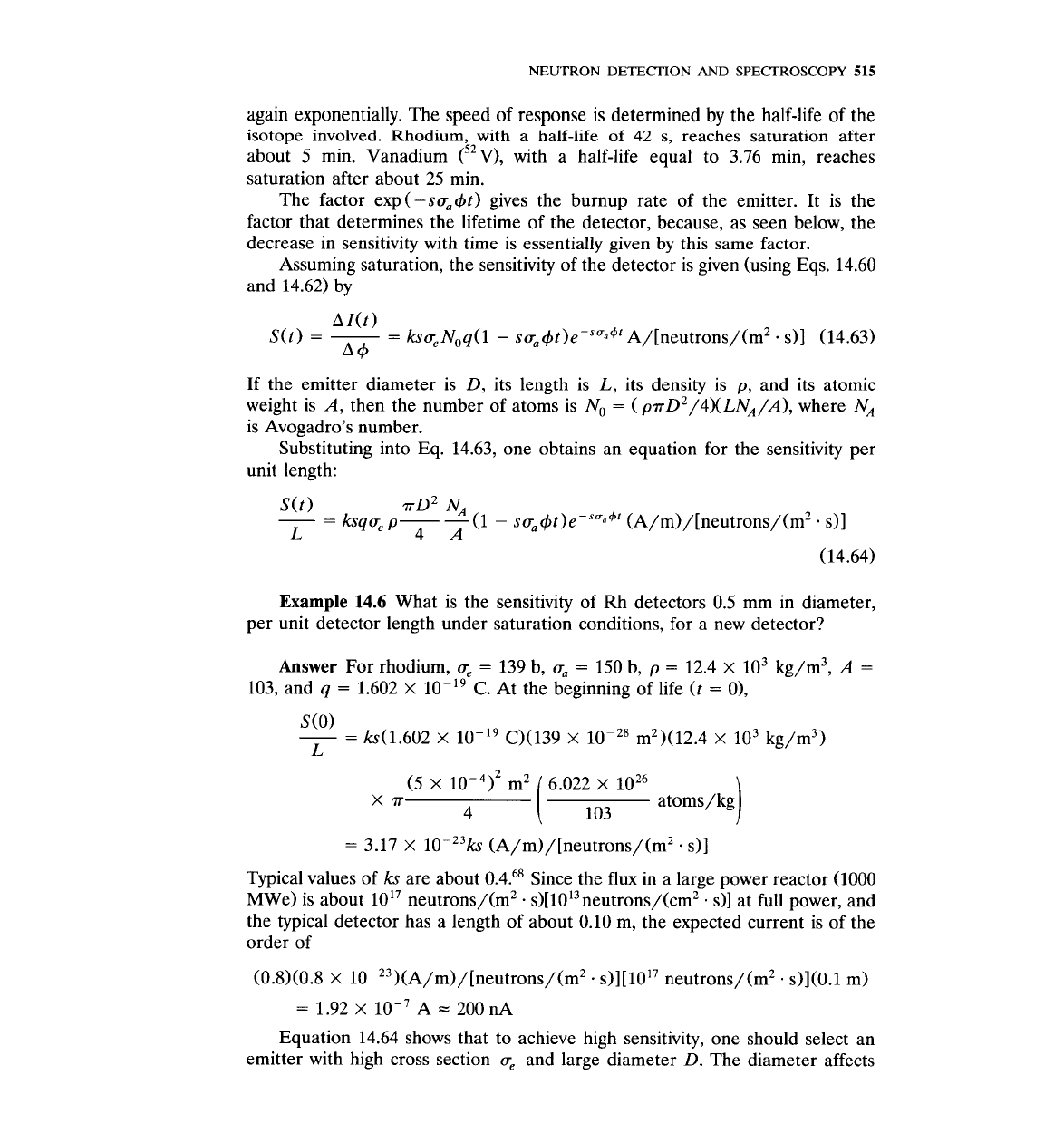
NEUTRON
DETECTION
AND
SPECTROSCOPY
515
again exponentially. The speed of response is determined by the half-life of the
isotope involved. Rhodium, with a half-life of
42
s, reaches saturation after
about 5 min. Vanadium (52~), with a half-life equal to 3.76 min, reaches
saturation after about 25 min.
The factor
exp(-sua+t) gives the burnup rate of the emitter. It is the
factor that determines the lifetime of the detector, because, as seen below, the
decrease in sensitivity with time is essentially given by
this
same factor.
Assuming saturation, the sensitivity of the detector is given (using Eqs. 14.60
and 14.62) by
If the emitter diameter is
D,
its length is L, its density is
p,
and its atomic
weight is A, then the number of atoms is
No
=
(
p~D2/4XLNA/A), where NA
is Avogadro's number.
Substituting into Eq. 14.63, one obtains an equation for the sensitivity per
unit length:
Example
14.6
What is the sensitivity of Rh detectors 0.5 mm in diameter,
per unit detector length under saturation conditions, for a new detector?
Answer
For rhodium,
ue
=
139 b,
a,
=
150 b,
p
=
12.4
X
lo3
kg/m3, A
=
103, and
q
=
1.602
x
10-19
C.
At the beginning of life (t
=
01,
=
3.17
X
10-23ks (A/m)/[neutrons/(m2. s)]
Typical values of
ks
are about 0.4.68 Since the
flux
in a large power reactor (1000
MWe) is about
loi7
neutrons/(m2
-
s)[1013neutrons/(cm2
.
s)] at full power, and
the typical detector has a length of about 0.10 m, the expected current is of the
order of
(0.8M0.8
X
l~-~~)(A/m)/[neutrons/(rn~
-
s)1[1017 neutrons/(m2
.
s)](0.1 m)
=
1.92
x
A
-
200nA
Equation 14.64 shows that to achieve high sensitivity, one should select an
emitter with high cross section
ue and large diameter
D.
The diameter affects
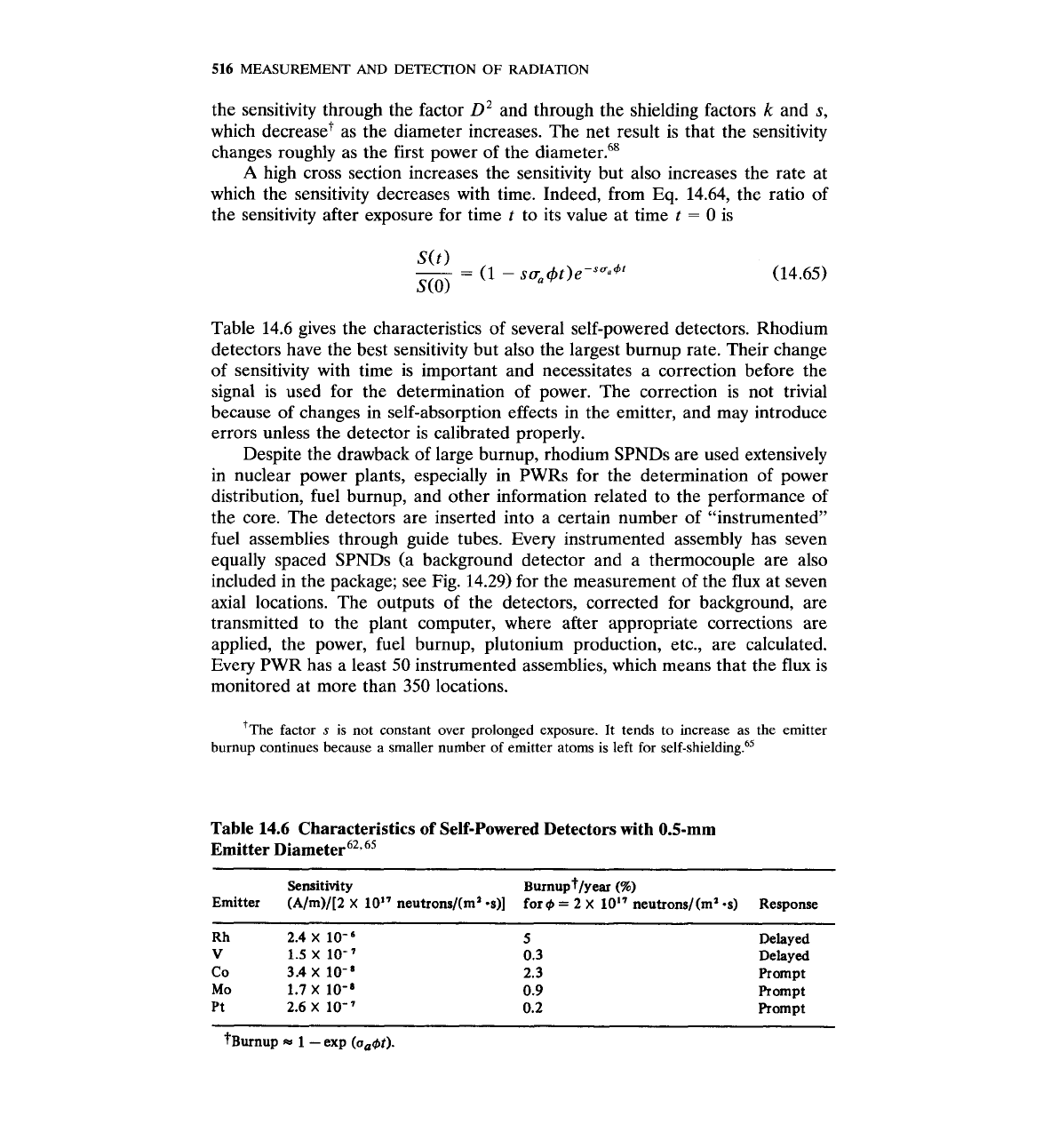
516
MEASUREMENT AND DETECTION
OF
RADIATION
the sensitivity through the factor
D~
and through the shielding factors
k
and
s,
which decreaset as the diameter increases. The net result is that the sensitivity
changes roughly as the first power of the diameter.68
A
high cross section increases the sensitivity but also increases the rate at
which the sensitivity decreases with time. Indeed, from Eq. 14.64, the ratio of
the sensitivity after exposure for time
t
to its value at time
t
=
0
is
Table 14.6 gives the characteristics of several self-powered detectors. Rhodium
detectors have the best sensitivity but also the largest burnup rate. Their change
of sensitivity with time is important and necessitates a correction before the
signal is used for the determination of power. The correction is not trivial
because of changes in self-absorption effects in the emitter, and may introduce
errors unless the detector is calibrated properly.
Despite the drawback of large burnup, rhodium SPNDs are used extensively
in nuclear power plants, especially in PWRs for the determination of power
distribution, fuel burnup, and other information related to the performance of
the core. The detectors are inserted into a certain number of "instrumented"
fuel assemblies through guide tubes. Every instrumented assembly has seven
equally spaced SPNDs (a background detector and a thermocouple are also
included in the package; see Fig. 14.29) for the measurement of the
flux
at seven
axial locations. The outputs of the detectors, corrected for background, are
transmitted to the plant computer, where after appropriate corrections are
applied, the power, fuel burnup, plutonium production, etc., are calculated.
Every PWR has a least
50
instrumented assemblies, which means that the
flux
is
monitored at more than
350
locations.
h he
factor
s
is not constant over prolonged exposure. It tends to increase as the emitter
bumup continues because a smaller number of emitter atoms is left for self-shielding.65
Table
14.6
Characteristics of Self-Powered Detectors with 0.5-mm
Emitter ~iarneter~~.
65
Sensitivity ~urnupt/year
(%)
Emitter
(A/m)/[2
X
lot7
neutrons/(ma .s)]
for
@
=
2
X
10'' neutrons/ (ma as)
Response
Rh
2.4
X
lo-=
5
Delayed
V
1.5
x
lo-1
0.3 Delayed
Co 3.4
X
lo-*
2.3 Prompt
Mo 1.7
X
lo-'
0.9 Prompt
Pt
2.6
X
lo-"
0.2 Prompt
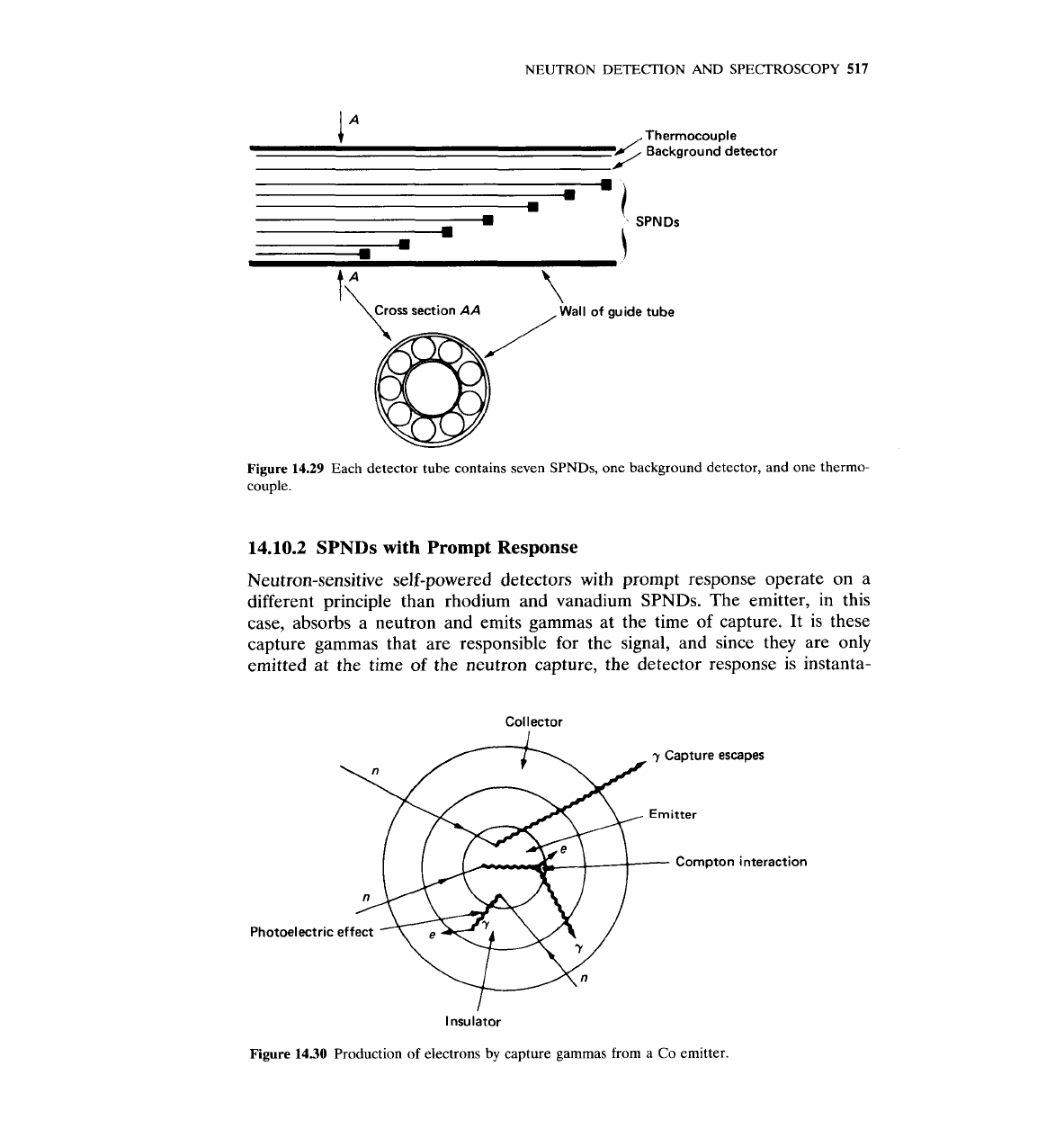
NEUTRON
DETECTION
AND
SPECTROSCOPY
517
Thermocouple
Background detector
Yros section
AA
/
wall of guide tube
Figure
14.29
Each detector tube contains seven SPNDs, one background detector, and one thermo-
couple.
14.10.2
SPNDs with Prompt Response
Neutron-sensitive self-powered detectors with prompt response operate on a
different principle than rhodium and vanadium SPNDs. The emitter, in this
case, absorbs a neutron and emits gammas at the time of capture. It is these
capture gammas that are responsible for the signal, and since they are only
emitted at the time of the neutron capture, the detector response is instanta-
Collector
